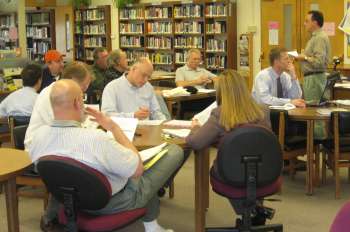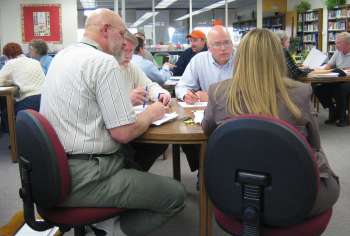- By Dan Veaner
- News
 Print
Print 
Both the Facilities and Public Awareness committees met for the third time Wednesday in their effort to rebuild Lansing School District's capital improvement project. After the Board of Education (BOE) withdrew an earlier proposal that would have cost taxpayers between $32 million and $40 million, Superintendent Mark Lewis proposed a plan where the community would build a new project from the ground up. The theory is that if the plan comes from the community, Lansing voters will support it when it comes up for a vote.
A key element of the plan is communications. Karen Winters, Associate/Director of Marketing for King & King Architects is meeting with residents Bud Shattuck, Mary Opperman, Maureen Bell and Doug Emerick to come up with a plan for informing the public about the project while at the same time soliciting input from residents. They will get the information about the project as it develops from the Facilities Committee and provide that committee with the feedback residents give them.
The facilities committee is somewhat larger with over 30 residents, parents, teachers, school administrators and two members of the BOE participating. That committee is facilitated by Mark Stammer, who is using a method of consensus building that turns the process used by the previous committee upside down, first defining priorities for programs and physical needs, and then developing ways to address them. On Wednesday Stammer tried to get the committee to prioritize a list of 22 concerns and issues the committee had identified in the last meeting by getting the committee to agree on how important it considers the seriousness of an issue, the urgency of fixing it and whether the condition would deteriorate if not addressed.
About two thirds of the session was wasted because of miscommunication about the process. Committee members, unfamiliar with this method, were confused by being asked to vote on problems and issues before being provided with any facts. Stammer asked the committee to go along with the process, promising they would understand it once they saw the results. But nearly half challenged the process, saying they couldn't vote on how important a problem is without knowing if it actually exists in our schools.

Committee members prioritize issues facing the campus
By meeting's end the voting was complete and members saw that the purpose was to set a list of priorities for the district. If a problem that was rated highly important does exist it will be considered first, while things that matter less to the community will only be considered if the committee perceives it to be financially feasible. If there is no problem, the priority will be skipped.
The process is structured so that the two committees meet simultaneously for an hour and a half, then get together for a half hour to report to each other. In the joint session Emerick explained that his committee had listed benefits and problems in the community that should be considered while developing a plan to sell the project to the public, while getting input from them that can be incorporated in the Facilities Committee's work.
Stammer went over the priorities voted on by his committee. Not surprisingly, fixing deteriorating facilities and planning efficient additions rated high, while traffic patterns on campus and efficiencies of moving students around the buildings and campus were low. A third committee, the Design Team, is made of architects, engineers and district administrators to provide information to the two citizens' committees as requested.
Now that priorities have been set the committee will be given tours of the schools to see first hand what the problems and needs are. It will look at program needs and attempt to come up with alternative ways to address them, so that if one turns out to be too expensive there are others that may be affordable.
The goal is for a recommendation to be presented to the BOE by June, which will fit a time table that will allow for a December referendum. Some committee members said that they think that is rushing the process. David Dittman questioned the wisdom of developing a capital project when the district doesn't have a long term plan in place. But Stammer and administrators say that by the time the committee needs to consider the long term plan it will be ready. Lewis has been working with a long term planning committee to develop it, and has indicated to the BOE that process is on schedule.
The two committees will meet again in two weeks.
(See "Lansing Schools Seek Community Input" for more on the capital project.)
----
v2i16



